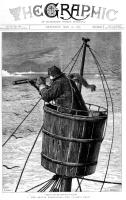
“The Arctic Expedition — the Crow’s Nest” 1875
The first of a two-part post on crows nests. Who would have thought that a crow’s nest deserves such attention?
A reader commented on the lack of a crow’s nest in the video of the Charles W. Morgan under sail that we posted over the weekend. While whaling ships and crow’s nests are closely associated in modern culture, most American whaling ships did not fit crow’s nests for their lookouts. The lookouts on the Charles W. Morgan probably watched for whales standing in open iron hoops.
The first crow’s nest is credited to Captain William Scoresby Snr., who said to have invented the barrel like shelter for whale ship lookouts in Arctic waters in 1807. William Scoresby and his son of the same name sailed from Whitby in North Yorkshire, UK, in the Greenland whale fishery. Before the introduction of the crow’s nest, also apparently known as a “hurricane house,” sailors made their own shelters of canvas. Here is Captain William Scoresby, Jr., son of Captain William Scoresby, Snr, describing the evolution of the crow’s nest. (He notably seems less concerned with the welfare of the sailors standing watch than he does the captain, who must also spend time at the masthead, from time to time.)
In difficult situations, a master’s presence at the mast-head is sometimes required for many hours in succession, when the temperature of the air is from 10° to 20° below the freezing point, or more. It is therefore necessary for the preservation of his health, as well as for his comfort, that he should be sheltered from the piercing gale. A piece of canvas tied round the head of the main top-mast, and heel of the top-gallant mast, extending only from the cap to the cross-trees, or at best, a canvas stretched round the base of the top-gallant rigging, but open on the after-part, was the most complete contrivance of a crow’s nest, until a few years ago my father invented an apparatus, having the appearance of a rostrum, which afforded an admirable defence against the wind.
This contrivance, from the comfortable shelter it affords to the navigator, having come into very general use, it may not be improper to describe it more particularly. The one most approved by the inventor is about four and a half feet in length, and two and a half in diameter. The form is cylindrical, open above and close below. It is composed of laths of wood, placed in a perpendicular position, round the exterior edge of a strong wooden hoop, forming the top, and round a plane of mahogany or other wood which forms the bottom, and the whole circumference of the cylinder is covered with canvas or leather. The entrance is by a trap-hatch at the bottom. It is fixed on the very summit of the main top gallant mast….”
Herman Melville spends a portion of Chapter 35, The Mast Head, of Moby Dick, in a somewhat satirical discussion of Scoresby’s invention. Melville refers to Scoresby as “Captain Sleet.”
Concerning all this, it is much to be deplored that the mast-heads of a southern whale ship are unprovided with those enviable little tents or pulpits, called crow’s-nests, in which the lookouts of a Greenland whaler are protected from the inclement weather of the frozen seas. In the fire-side narrative of Captain Sleet, entitled “A Voyage among the Icebergs, in quest of the Greenland Whale, and incidentally for the re-discovery of the Lost Icelandic Colonies of Old Greenland;” in this admirable volume, all standers of mast-heads are furnished with a charmingly circumstantial account of the then recently invented crow’s-nest of the Glacier, which was the name of Captain Sleet’s good craft. He called it the Sleet’s crow’s-nest, in honor of himself; he being the original inventor and patentee, and free from all ridiculous false delicacy, and holding that if we call our own children after our own names (we fathers being the original inventors and patentees), so likewise should we denominate after ourselves any other apparatus we may beget. In shape, the Sleet’s crow’s-nest is something like a large tierce or pipe; it is open above, however, where it is furnished with a movable side-screen to keep to windward of your head in a hard gale. Being fixed on the summit of the mast, you ascend into it through a little trap-hatch in the bottom. On the after side, or side next the stern of the ship, is a comfortable seat, with a locker underneath for umbrellas, comforters, and coats. In front is a leather rack, in which to keep your speaking trumpet, pipe, telescope, and other nautical conveniences. ……
While it appears that Captain Scoresby deserves credit for the crow’s nest, many claim that the name, at least, is far older, perhaps dating back to the Vikings. Also, many medieval ships appear to have crow’s nests at their mastheads. If they are not crow’s nests, what are they? Check back tomorrow for “Crow’s Nests : Part 2 — Floki, the Ravens and Fighting Tops.”

Excellent material!
SS United State’s Crows nest is even more advanced than iron hoops, and wooden Barrels. Today’s ships, not so much, right.